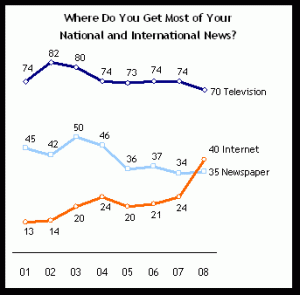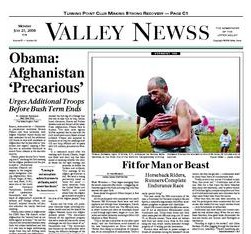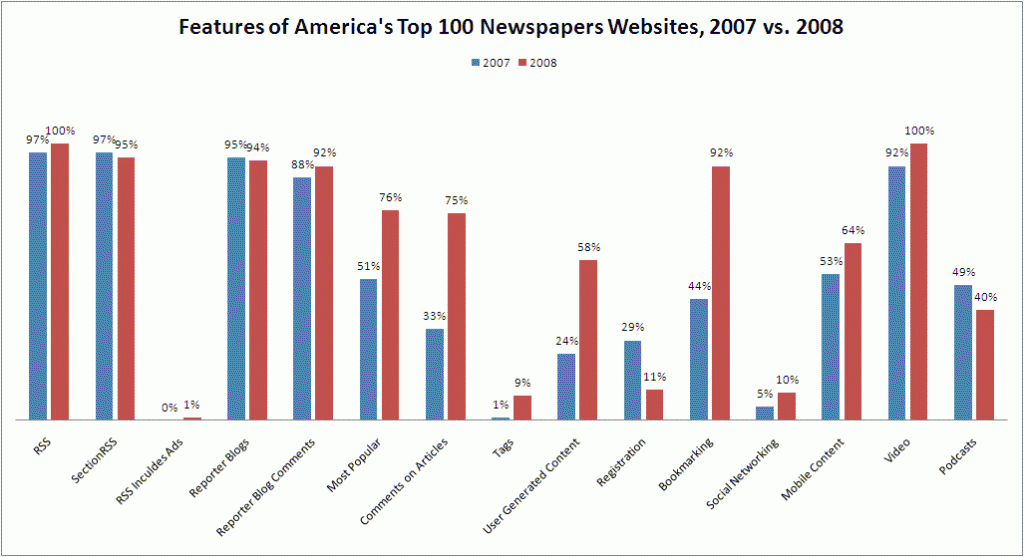 Last night I attended a dinner hosted by the Boston Globe for the stated purpose of gaining insight from a small group of new-media enthusiasts about its Boston.com website. The evening turned into a wide-ranging discussion about the future of the Globe itself, with no clear consensus emerging. I was struck by the vision that the Globe showed when it launch Boston.com 13 years ago and how that vision was later clouded by conventional newspaper wisdom.
Last night I attended a dinner hosted by the Boston Globe for the stated purpose of gaining insight from a small group of new-media enthusiasts about its Boston.com website. The evening turned into a wide-ranging discussion about the future of the Globe itself, with no clear consensus emerging. I was struck by the vision that the Globe showed when it launch Boston.com 13 years ago and how that vision was later clouded by conventional newspaper wisdom.
Boston.com was originally intended to be a destination site for residents of the Boston area. It was launched at a time when nearly every metro daily was going online, most under their own brands. The Globe took a different approach: Boston.com would be branded and focused on a region rather than an existing print property. The Globe even enlisted some local media partners to contribute content and share in the profits. Those partners have mostly fallen away over the years, but the vision of the newspaper’s website as a geographic focal point was a precursor of the “hyper-local” concept that’s so popular in the industry today.
Blurred Vision
That vision didn’t carry through, though. With news editors running the show, Boston.com over the years increasingly looked like the front page of the Globe. National and international headlines shared the home page with local copy and the site lost its regional distinctiveness. Suburban bureaus were axed in the name of cost savings. As a resident of a nearby town, I personally found that my information needs were better met by small sites that were tightly focused on topics or regions that matter to me.
Now the Globe is trying to get back some of the distinctiveness of Boston.com. There’s no question that the site is more local today than it has been in years, but the online landscape has changed as well. Some of the questions that came up during the meeting:
Does a website even matter anymore? So many people get their news through feeds and aggregators that the idea of a website as a destination may be outmoded.
Is brand important? Maybe The New York Times brand is, but does the Boston Globe‘s brand strike enough of a chord in people’s minds to distinguish its value? Brand may be the only thing newspapers have left in the long run, so that’s a critical question.
How local does the site need to be? Many communities in the greater Boston area are served well by e-mail lists, community newspapers and even individual bloggers. How granular does a major metro need to get in order to be truly hyper-local?
Who’s going to do the grunt work? Part of the service that major metro dailies perform is sitting through tedious budget committee meetings and city council sessions. It’s a little-appreciated loss leader for newspapers, but it’s essential to their watchdog role. What blogger in his or her right mind is going to do that?
In my humble opinion, the Globe should do the following:
- Create Huffington Post-style bureaus in local communities, with news provided by stringers and citizens. Many reporters for community weeklies make little or no money, so the exposure in the Globe would be an incentive for them.
- Borrow a page from Yelp.com, Going.com and Angie’s List and become the dominant source of buying advice for local products, services and activities.
- Ramp up its custom publishing arm to help local companies become legitimate publishers in their own right. Many businesses want to take advantage of new media to do this, but their efforts are mostly terrible.
- Treat print as a cash cow and manage it downward gracefully while building new revenue streams. Further cutbacks are inevitable, but it would be nice to balance that with some growth.
- Take a hatchet to the sales force, focusing on hiring and retaining people with classified advertising experience. Future revenues are going to come from local businesses, so invest in the people who can sell to them.
The group from the Globe listened attentively and appeared to take the input seriously. Unfortunately, the barn door has already closed on print and the declining revenue picture offers fewer options for investment with every passing day. But Boston.com is a nice website.
Envisioning a Future Without the Times
Writing in the Atlantic, Michael Hirschorn starts with an outrageous statement: what if The New York Times folds its print newspaper four months from now? Okay, it’s not likely to happen, Hirschorn writes, but the way The New York Times Co. is spiraling downward, the Big Apple’s intelligentsia should prepare for a day when they won’t have a newspaper to read in their SoHo coffee houses.
Hirschorn goes on to present a well-written summary of the changes readers are likely to see as newspapers exit the scene. “Common estimates suggest that a Web-driven product could support only 20 percent of the current staff; such a drop in personnel would (in the short run) devastate The Times’ news-gathering capacity,” he notes, suggesting that international coverage will almost disappear in the process. “Internet purists may maintain that the Web will throw up a new pro-am class of citizen journalists to fill the void, but for now, at least, there’s no online substitute for institutions that can marshal years of well-developed sourcing and reporting experience.”
Ultimately, emerging sources like Huffington Post and Talking Points Memo may create a new model for participatory journalism, but the quality of services they provide will be more erratic and unpredictable that those readers have known in the past. New-media operations needs to maintain low overhead. Huffington “is the prototype for the future of journalism: a healthy dose of aggregation, a wide range of contributors, and a growing offering of original reporting.” Since few of those contributors are paid, what you see is what you get.
For Better or Worse, China Invests in Newspapers
“As international media is contracting, China is going in the other direction,” says Doreen Weisenhaus, a media law professor at the University of Hong Kong, in an opinion piece by Forbes‘ Robyn Meredith, about China’s ambitious plans to expand its international media presence. Meredith says China plans to spend $6.6 billion to build the staffs of China Central TV, People’s Daily and other news organizations both on the mainland and around the world. US bureaus are planned, among others, and new Chinese-owned, English-language newspapers will be launched in the U.S. and China.
The problem, Meredith says, is that China doesn’t have a free press. Although controls were loosened somewhat during the 2008 Summer Olympics, there’s no indication that these expanded news organizations will be allowed to say anything that displeases the government. The result could simply be an expansion of the Chinese propaganda machine. And if someone gets the idea to spend some of that $6.6 billion buying up distressed US newspapers, well, it’s not a pretty thought.
Layoff Log
Miscellany
 We’ve noted several examples of newspapers burying the lead in reporting on their own layoffs. So give credit to the Seattle Post-Intelligencer for doing the opposite. Not only did SeattlePI.com cover the announcement of its likely sale or closure in detail, but now the paper’s managing editor, David McCumber, has launched a blog to document the 60 days until decision time. It’s an honest, personal and well-written account of the many thoughts are no doubt going through his mind as the clock ticks away.
We’ve noted several examples of newspapers burying the lead in reporting on their own layoffs. So give credit to the Seattle Post-Intelligencer for doing the opposite. Not only did SeattlePI.com cover the announcement of its likely sale or closure in detail, but now the paper’s managing editor, David McCumber, has launched a blog to document the 60 days until decision time. It’s an honest, personal and well-written account of the many thoughts are no doubt going through his mind as the clock ticks away.
Erica Smith, whose Paper Cuts maps mashup is de facto official record of newspaper industry layoffs, has put together a nice list of newspapers that use Twitter. Such a roster is automatically out of date the minute it’s posted, but it gives you a good idea of how various news organizations are segmenting their coverage and also where the list of followers is growing fastest. You can also see who gave up early. BTW, the Paper Cuts counter has been reset for 2009.
 Veteran travel editor John Flinn recently took a buyout package from the San Francisco Chronicle. He’s not bitter or angry, but he’s a bit wistful about how the industry’s troubles are affecting his specialty area. Travel scribes are a different breed of feature writer, each with a unique voice and a different way of going about the job. Sadly, they are being replaced by “utility infielders” with their top-10 lists and “charticles.” But Flinn isn’t looking back. He’s hitting the road soon in his VW Westfalia pop-top camper van.
Veteran travel editor John Flinn recently took a buyout package from the San Francisco Chronicle. He’s not bitter or angry, but he’s a bit wistful about how the industry’s troubles are affecting his specialty area. Travel scribes are a different breed of feature writer, each with a unique voice and a different way of going about the job. Sadly, they are being replaced by “utility infielders” with their top-10 lists and “charticles.” But Flinn isn’t looking back. He’s hitting the road soon in his VW Westfalia pop-top camper van.
Give-Us-A-Break Department: “The vast majority of Americans believe the U.S. media industry’s coverage of the faltering economy is actually contributing to the economic crisis by ‘projecting fear into people’s minds.’ That’s the finding of a survey of 1,000 U.S. adults released Thursday by Opinion Research Corporation. The survey, which was conducted last month via telephone, found that 77% of respondents believe fear mongering by U.S. media outlets is negatively impacting consumer confidence in the economy.” – MediaPost, 1/2/09.
 Yesterday was black Thursday in newspaper land as four media companies reported dismal earnings, seven small newspapers shut down and publishers braced the public for more layoffs.
Yesterday was black Thursday in newspaper land as four media companies reported dismal earnings, seven small newspapers shut down and publishers braced the public for more layoffs.




 Last month we told you about new Gallup research that showed
Last month we told you about new Gallup research that showed 






